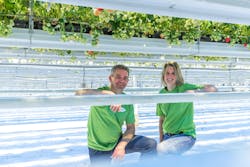With energy prices soaring, a year-round Dutch strawberry grower has wasted no time deciding that its first voyage into LED lighting merits more of the same.
Kwekerij Loos plans this September to replace all high-pressure sodium (HPS) lights in two greenhouses — one at its home base in Moerstraten and the other in nearby Lepelstraat — covering about 4 hectares, and bringing its total LED lighting area to 6 hectares.
The company will install a combination of LED toplights and LED flowering lights from Signify, the same supplier it tapped last year when it replaced about half the HPS lights at the Moerstraten location with LEDs over 2.1 hectares.
“With the current energy prices, you start looking at how you can make your cultivation practices as efficient as possible,” said co-owner Arno Loos. “You’ll quickly discover that LED lighting is the best solution.”
Loos anticipates energy savings of around 40% compared to energy consumption with the HPS lights.
“If current energy prices persist, which is of course not to be hoped for, we can recoup our investment in three to four years,” he noted. Neither Loos nor Signify revealed how much Loos is paying for the lights, or how many he is purchasing.
The parties said that in total Kwekerij Loos will use the same number of lights as it has been with HPS, but it will raise lighting levels from 195 to 220 µmol/m2.
“We anticipate an increase in production, but how much remains to be seen,” Loos said.
The lights appear to include Signify’s new “FR” strawberry-specific toplights, which deliver a recipe that includes far red.
“We were looking for a light spectrum with more far-red and some green light,” said Loos. “The addition of far-red light to the customary red/blue spectrum encourages the elongation of petioles and trusses in the winter period. With the new FR_5 spectrum, we’re able to achieve an optimum light level for strawberry plants. In those moments when we don't need any far-red light, we can switch off these lamps.”
One consequence of replacing inefficient HPS is that the grower won’t benefit from HPS’ excess radiant heat, which can be useful in the winter. In those instances, Kwekerij Loos will bring heat from other sources into the greenhouses, a Signify spokesperson told LEDs Magazine.
Many growers who are adding LEDs to their mix have had to contend in one way or another with the absence of HPS heat, which can sometimes be a detriment and at other times a benefit.
Last week LEDs noted that after a partial LED conversion, year-round Belgian tomato grower Tomerel actually found it cheaper to provide extra heat from an onsite co-generator than to rely on the heat that had radiated from electricity-powered HPS luminaires. Tomerel uses a gas engine to generate electricity and heat. It uses some of the electricity to power its grow lights and sells some of it to the grid utility.
Tomerel’s LED luminaires come from Signify’s Fluence business; the Kwekerij Loos luminaires come from Signify’s Horticultural LED Solutions division.
Kwekerij Loos’ year-round retail outlets include strawberry vending machines. The company also grows asparagus, farming it outdoors without grow lights.
MARK HALPER is a contributing editor for LEDs Magazine, and an energy, technology, and business journalist ([email protected]).
For up-to-the-minute LED and SSL updates, follow us on Twitter. You’ll find curated content and commentary, as well as information on industry events, webcasts, and surveys on our LinkedIn page and our Facebook page.






